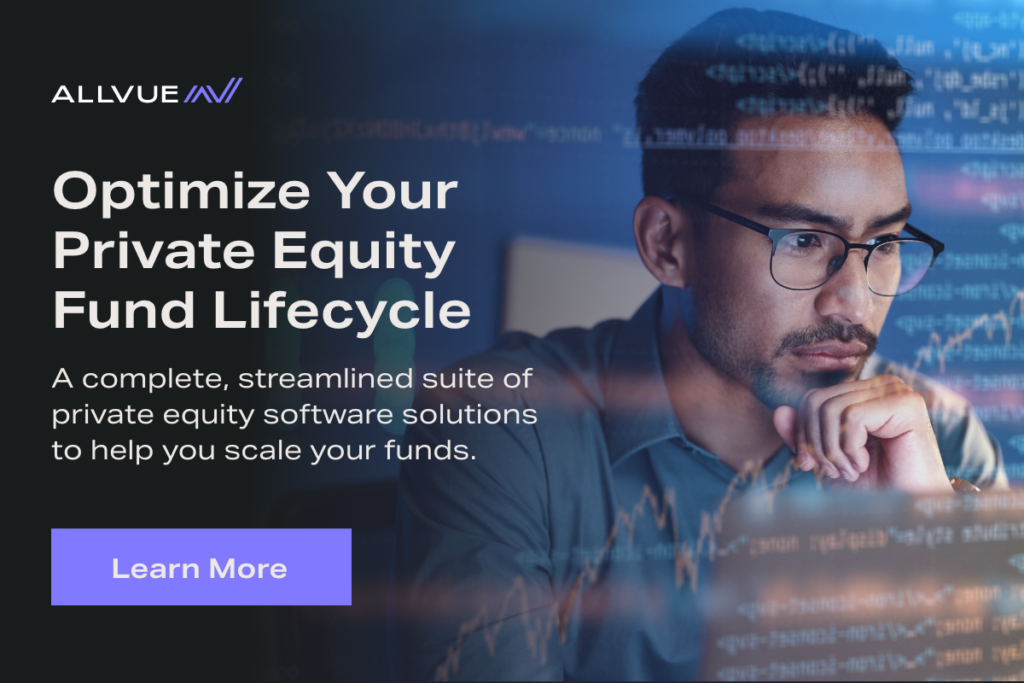
By: Michelle Wu
Head of Marketing
April 19, 2024
Private equity (PE) has been one of the most exciting developments in finance since it first rose to national prominence in the 1980s. As an alternative to investing in public markets, PE offers institutions and individual investors much more flexibility to shape the direction of privately held companies, maximizing their ROI through managers’ active rather than passive methods.
Despite recent updates to PE rules, regulation in the sector remains relatively lax.
Still, without strict laws or guidelines about how they must work, many PE funds utilize a similar structure, with well-established conventions in terms of who the primary stakeholders are, how the investment and payouts work, and how PE funding evolves over time.
We’ll cover all of this below, along with how PE fund structures can vary based on individual funds’ priorities.
Stakeholders in private equity funding
PE funds are investment vehicles focused on private companies rather than public ones, which are often beholden to regulatory and other requirements. In a typical PE fund or PE firm, the investments are collected from limited partners (LPs) and managed by general partners (GPs), who often take up management responsibilities in companies acquired (“portfolio companies”).
PE funding is made up of institutional contributions, such as collective investments from group insurance and pension plans. High-net-worth individuals also make up a large portion of a PE firm’s LP base.
NOTE: Unlike other investment vehicles, PE funds are not legally restricted to “accredited investors.” Per the Securities and Exchange Commission (SEC), only individuals who earn over $200K per year, have a net worth over $1M, or meet alternative criteria are able to invest in unregistered and certain other securities.
General partners (GPs) and limited partners (LPs)
The term “general partner” in private equity describes the individuals or firms who manage a PE fund throughout its lifecycle, from the initial formation through the eventual investment exit. GPs also take on managerial and operations responsibilities—or delegate these to professionals that they carefully select—to ensure and accelerate growth at companies acquired or invested in.
GPs make or inform investment decisions and carry the most legal liability for their results.
Their other responsibilities include targeting, courting, and managing LPs, who make up the majority of funding for a PE firm. GPs’ incentives are tied to performance fees based on returns (see below), but they often also invest their own capital to signal their alignment with LPs.
LPs are investors who fund PE initiatives and enjoy the majority of the profits when the fund exits. LPs’ involvement is passive, and their liability is typically limited to their investment.
How private equity investments and payouts work
The formal structure on which almost all PE funding is built is a limited partnership agreement (LPA), which governs the specific relationships between GPs, LPs, and all other stakeholders.
The LPA outlines the specifics of LPs’ investments, including minimum contributions and the liability they’re exposed to for them—this is typically limited to their investments only. LPAs also detail the specifics of LP returns, including profits from a successful exit along with “dividend recapitalization” (often paid through new debts undertaken by companies to limit LP exposure).
LPAs also outline fees charged by GPs that LPs need to account for alongside contributions:
- Carried interest – “Carry” in industry parlance, these are performance fees that GPs and associated investment professionals collect from the profits of a PE exit. Typically about 20% of the total profits, the fees ensure alignment between GP and LP interests.
- Management fees – These are fees paid by LPs to GPs for the selection and maintenance of investments, including active management in portfolio companies. Irrespective of performance, investors can expect to pay approximately 2% of their commitment.
Other fees (i.e., monitoring or transaction) may apply. But these auxiliary expenses are often offset by management fees—or eschewed altogether—in favor of the standard “two and 20.”
The stability of this structure points to its effectiveness—and investors’ trust in it—irrespective of market climates. For example, even amid challenges to the PE ecosystem, McKinsey notes that private assets under management have grown about 20% annually since 2018.

The timeline of private equity funding
Another critical part of PE funding structure is its timeline. LPAs typically outline a finite lifecycle for the fund, which often spans 5-10 years from the initial fund formation to the ultimate exit.
While short-term PE funding does exist, the (relative) long game is the more traditional focus.
It’s important to keep this long-term strategy in mind, especially in the context of recent struggles across the PE landscape. According to Bloomberg, PE payouts fell 49% over the past two years. And, per S&P Global, PE fundraising in 2023 represented a 6-year low. However, a change is likely on the horizon. Experts at EY have highlighted that 2023 closed on a strong note for PE funds, with Q4 activity up 11% and totaling $124B in value ($71B in November alone).
Initial formation and fundraising
Well before any management or exit strategies, PE funds need to get off of the ground. This starts with an enterprising GP deciding on a business strategy and seeking out investors (LPs).
In practice, this means that GPs select a specific niche to focus on. Common points of interest include specific industries (i.e., tech, healthcare), businesses of a certain size or maturity (i.e., startups or legacy, public businesses to bring private), location, or any combination thereof.
An important consideration here is whether and how specific non- or meta-financial initiatives will shape the firm’s investment strategy. For example, many PEs target environmental, social, and governance (ESG) objectives (i.e., decarbonization, ethical management) alongside profit.
There are significant benefits—financial and otherwise—to ESG investing and reporting in PE.
Once a fund’s priorities and strategies are determined, GPs seek out LPs capable and willing to realize their vision. As noted above, these are often institutions (e.g., university endowments) or wealthy individuals who can provide funds at volume, over time, and bear the requisite risk.
Portfolio selection and investment
Next, PE funds need to invest the funds they’ve raised, carefully, in select companies. With a clearly defined goal, this process should be seamless. However, objectives and strategies may evolve over time depending on the interests or insights of LPs and GPs, along with market conditions. Regardless of focus, PE funds can find success in a wide variety of industries.
For example, consider some of the biggest PE investments of 2023:
- Japan Industrial Partners brought automotive giant Toshiba private ($15.2B valuation)
- GTCR coordinated a leveraged buyout of software firm Worldpay ($11.4B valuation)
- Apollo Funds executed a merger including chemical provider Univar ($8.1B valuation)
Along with variety in industry niches, these examples point to a variety of strategies for buying or investing in companies. PE funds typically purchase stakes in private companies, but they may also target larger publicly traded companies to bring private. In all cases, the goal is to maximize the company’s profitability through management, strategic mergers, and/or an eventual exit.
Active management and harvest
One thing that distinguishes PE from other investment vehicles is the active role PE funds and their stakeholders take in (re)shaping portfolio companies. In practice, this means that GPs influence decisions about staffing, product and service offerings, and all other operations.
Leveraging expertise and cutting-edge data analytics, GPs’ goal is to make companies the best versions of themselves. In this way, they maximize performance and revenue in the short term.
However, GPs are also concerned with optimizing operations to maximize a company’s value over the long term. Common exit strategies include preparing for an initial public offering (IPO), executing a strategic sale, or coordinating a secondary or management buyout (MBO).
For example, consider two of the most newsworthy PE exits of 2023:
- Thoma Bravo acquired AxiomSL in 2020, then Calypso in 2021. After merging the two companies into Adenza, it executed a strategic sale ($10.5B valuation) in June 2023.
- L Catterton invested in ODDITY in 2017, leading to an IPO ($2.3B valuation) in July 2023.
As the variety here shows, methods and timelines can vary widely based on a fund’s or firm’s strategic goals. These points of focus can also impact the overall structure of PE funding.
How private equity focus impacts structure
On one level, there are differences in the kinds of investments that PE funds target. For instance, venture capital funds (a form of PE) typically target startups, often in the tech sector. But real estate PE funds, as their name implies, target properties and developers almost exclusively.
On another level, there are differences in the ways PE funds go about managing the concerns they invest in. For example, a venture capital fund may prefer a more “hands-off” approach to foster the creativity necessary in an industry like tech. Whereas a PE firm might buy a mature but struggling company with the intent of turning them around, taking a much more “hands-on” approach in terms of allocating resources and pursuing strategic partnerships (or mergers) to accelerate profitability.
In all cases, these priorities are reflected in the specific structuring of a PE fund. The investors it targets, specifics of the LPA, lifecycle, and payouts are all impacted by a fund’s strategic focus.
Optimizing private equity fund performance
Private equity firms vary in the specifics of their goals and strategies, but the general structure they employ is relatively consistent (if not perfectly uniform). Another consistency is the need for quality data collection and management to facilitate all parts of a fund’s lifecycle, from business strategy through fundraising and portfolio selection to the ultimate exit.
Allvue provides software products tailored to the specific needs of private equity.
Our private equity software platform integrates seamlessly within the tech stacks GPs are already accustomed to, and it’s both usable out-of-the-box and ready for long-term scaling as soon as it happens.
To learn more, get in touch today—or request a demo to see firsthand how Allvue can help you.
Sources:
AIC. Private Investment Explained: Dividend Recapitalization. https://www.investmentcouncil.org/private-investment-explained-dividend-recapitalization/
Bloomberg. Private Equity Payouts at Major Firms Plummet 49% in Two Years. https://www.bloomberg.com/news/articles/2024-02-21/private-equity-payouts-at-major-firms-plummet-49-in-two-years
- Private Equity Pulse: key takeaways from Q4 2023. https://www.ey.com/en_us/private-equity/pulse
Investopedia. What Is the Structure of a Private Equity Fund?. https://www.investopedia.com/articles/investing/093015/understanding-private-equity-funds-structure.asp
Investor.gov (SEC). Accredited Investors – Updated Investor Bulletin. https://www.investor.gov/introduction-investing/general-resources/news-alerts/alerts-bulletins/investor-bulletins/updated-3
McKinsey & Co. Private markets: A slower era. https://www.mckinsey.com/industries/private-equity-and-principal-investors/our-insights/mckinseys-private-markets-annual-review
Private Funds CFO. The complex world of management fees. https://www.privatefundscfo.com/the-complex-world-of-management-fees/
S&P Global. Private equity fundraising plunges to 6-year low in 2023. https://www.spglobal.com/marketintelligence/en/news-insights/latest-news-headlines/private-equity-fundraising-plunges-to-6-year-low-in-2023-79994493
USPEC. Deciphering Private Equity Fund Structure: An In-Depth Guide. https://www.uspec.org/blog/deciphering-private-equity-fund-structure-an-in-depth-guide
More About The Author

Michelle Wu
Head of Marketing
Michelle is a dynamic marketing leader with 15+ years of experience in capital markets, fintech, and cybersecurity technology industries. Prior to joining Allvue, Michelle was the Vice President of Product Marketing at SecurityScorecard, a global leader in cybersecurity ratings, and was the Head of Security & Compliance Marketing at Box. Before moving into cybersecurity, she led the Banking & Securities GTM strategy at Intralinks and covered capital markets clients at HSBC. She holds an MSc in Media & Communications from the London School of Economics and a BS in Marketing & Finance from NYU Stern School of Business.



